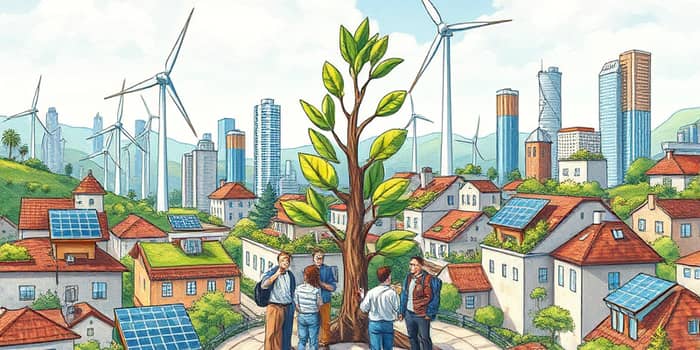The global push toward sustainability has reached a critical inflection point. As governments, corporations, and communities seek to combat climate change and social inequities, the role of finance has become ever more central.
Innovative lending solutions are not only channeling capital into green corridors but also shaping the trajectory of economic growth. By aligning financial returns with environmental and social outcomes, stakeholders can foster resilient ecosystems and inclusive prosperity.
Market Overview and Growth
In 2024, the global sustainable debt market exceeded US$1.6 trillion, marking an 8% rise over the previous year. This expansion underscores escalating demand from investors and issuers committed to environmental, social, and governance goals.
Cumulative GSS+ (green, social, sustainability, and sustainability-linked) volume reached USD 5.7 trillion by year-end, while issuance alone hit USD 1.1 trillion in alignment with the Climate Bonds Initiative. Projections suggest that global sustainable bond issuance will hover around US$1 trillion in 2025, cementing this sector’s foothold in mainstream finance.
Types of Sustainable Loans
Financial institutions have tailored multiple lending structures to meet varied project needs. The three primary categories are:
- Sustainability-Linked Loans (SLLs): With interest rates tied to environmental performance metrics, SLLs saw an 18% surge to US$463 billion in 2024.
- Green Loans: Designed exclusively to fund projects with environmental benefits, these loans hit a record level for Green Loans at US$162 billion, a 31% increase year-over-year.
- Social Loans: Targeting community development and social welfare initiatives, Social Loans climbed 45% to US$13 billion, marking their strongest year yet.
Sectoral and Regional Trends
Borrowers in the Utility & Energy sector led the charge, with nearly US$120 billion in sustainable loan issuance during 2024. Real Estate, Financials, and Technology also emerged as significant contributors, reflecting cross-industry commitment to green transition.
Regionally, sustainable loan penetration shifted notably. EMEA’s rate dipped from 21% to 19%, North America fell from 7% to 5%, while APAC climbed from 14% to 19%, driven by rising green issuance amidst shrinking overall loan volumes.
Government Initiatives Driving Change
Policy frameworks and public funding have played catalytic roles in scaling green finance. In the U.S., the Inflation Reduction Act spawned the U.S. Greenhouse Gas Reduction Fund, allocating US$27 billion to mobilize private capital for clean energy projects. The EPA has awarded these grants, and a separate Solar for All program disburses US$7 billion to bring residential solar to low-income communities, yielding US$350 million in annual savings for beneficiaries.
Innovative Financial Instruments
Beyond standard loans, a spectrum of instruments caters to sustainability agendas:
- Green Bonds: Popular for financing large-scale renewable energy and infrastructure projects.
- Blended Finance Funds: Combining public, private, and philanthropic capital to de-risk investments in emerging markets and nature-based solutions.
- Direct Asset Investments: Funding permanent carbon sinks like forests and wetlands to generate environmental and social returns.
Outlook and Challenges for 2025
While sustainable lending grew 21% in 2024, the overall syndicated loan market expanded by 37%, causing the aggregate penetration rate to dip to 10% from 12%. Looking ahead, key drivers for increased issuance include:
- new definitions for taxonomies that clarify eligible assets and activities;
- heightened spending on adaptation and resilience projects;
- greater visibility for insurance companies in sustainable finance.
Potential headwinds include shifting U.S. policy stances with global implications and regulatory uncertainty stemming from the European Commission’s Omnibus simplification agenda, which questions key provisions of CSRD and CS3D.
Bridging the Financing Gap and Mitigating Risks
The annual financing gap for sustainable development has ballooned from US$2.5 trillion to US$4 trillion—an increase of 60%. Addressing this shortfall requires scaled-up capital flows and innovative risk mitigation mechanisms.
Greenwashing concerns persist, as some issuances fall short of genuine impact. To combat this, new standards are emerging to delineate bonds that support nature-based initiatives, while blended finance institutions strive to structure vehicles that rarely exceed US$100 million, ensuring tangible outcomes.
Leadership and Best Practices in Sustainable Finance
Industry frontrunners set the bar for excellence. BNP Paribas, for instance, has garnered accolades across sustainability bonds, green bonds, and sustainability-linked loans. Meanwhile, the Climate Bonds Initiative plays a pivotal role in establishing methodologies, tracking market data, and certifying compliant issuances.
Best practices include rigorous impact reporting, transparent governance frameworks, and stakeholder engagement to align project execution with promised outcomes. By adopting these principles, financial institutions and borrowers can build trust and accelerate capital deployment.
Conclusion: Paving the Way for a Sustainable Future
Loans for sustainable projects represent more than a financing mechanism; they embody a collective vision for a resilient, equitable, and low-carbon world. Through collaboration among public and private actors, capital can be steered toward transformative initiatives that yield environmental dividends and social upliftment.
As the market matures and regulatory clarity improves, stakeholders must remain vigilant against greenwashing and continue innovating financial solutions. By committing to impact-driven investment strategies and upholding best practices, we can unlock the full potential of green finance and ensure that capital flows responsibly to the projects that matter most. The path to sustainability is paved with purpose-driven lending, and 2025 promises to be a year of unprecedented opportunity and collective achievement.
References
- https://gsh.cib.natixis.com/our-center-of-expertise/articles/sustainable-debt-in-focus-2024-summary-and-2025-outlook
- https://www.tdsecurities.com/ca/en/sustainable-finance-outlook-2025
- https://www.moodys.com/web/en/us/insights/credit-risk/outlooks/esg-sustainable-finance-2025.html
- https://www.oecd.org/en/publications/global-outlook-on-financing-for-sustainable-development-2025_753d5368-en.html?wcmmode=disabled.html
- https://www.climatebonds.net/resources/press-releases/2025/01/climate-bonds-publishes-provisional-2024-numbers-and-key-factors
- https://www.epa.gov/greenhouse-gas-reduction-fund
- https://www.environmental-finance.com/content/awards/environmental-finances-sustainable-debt-awards-2025/winners/










